The Gift of South Dakota
Subscriptions to South Dakota Magazine make great gifts!
Subscribe today — 1 year (6 issues) is just $29!
Pedestrian Politics
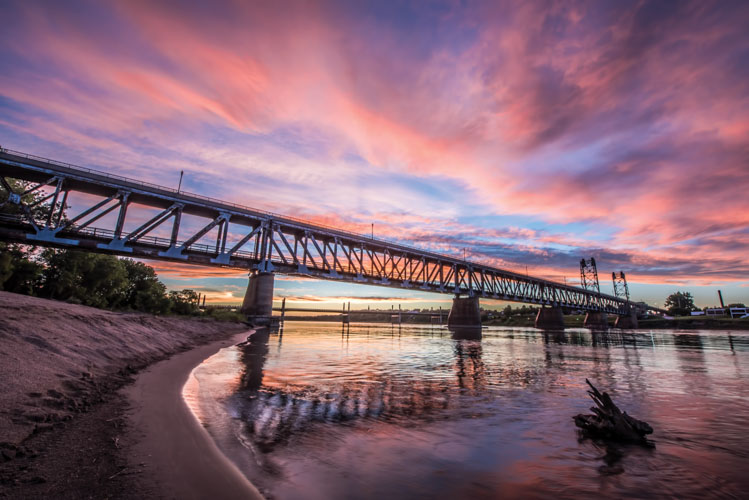 |
| Yankton's Meridian Bridge carried traffic across the Missouri River between South Dakota and Nebraska from 1924 until its closure in 2008, which ushered its new life as a pedestrian walkway. Photo by Pat Hansen |
Bridges are famously controversial. Yankton’s double-deck Meridian Bridge, which turns 100 years old this year, is a classic example.
In the 1920s, Yankton booster D.B. Gurney and his supporters sought to circumvent the political process by raising private funds, but they still had to navigate approval from both Washington and Pierre before they could drop the first barrel of concrete into the Missouri River channel in 1922.
They also confronted politics within the Yankton community as they cajoled friends and neighbors to make major investments in the bridge. Gurney once donned boxing gloves for a meeting and suggested that the fundraising could require fisticuffs. Though Gurney’s friends thought he was joking, they quickly offered more money.
When the $1.1 million Meridian Bridge opened on Oct. 11, 1924, it became the first highway bridge constructed across the Missouri River in South Dakota. The double-decker design was chosen in anticipation of a railroad line that never materialized, so motorists driving south into Nebraska used the lower deck and northbound traffic took the upper. Drivers paid tolls until the cost was recouped in December of 1953. Gurney’s wife Henrietta paid the final toll.
Seven decades after the first cars rolled across, Meridian Bridge politics re-emerged as local and state leaders debated where to build its replacement. Then, even after the Discovery Bridge was completed, the Meridian was not free of politics. In fact, some of the old bridge’s most highly charged moments came in 2008 and 2009, after it was closed and slated for demolition.
The new Discovery Bridge was opened to traffic on Oct. 11, 2008 — the same date as the Meridian’s official opening 84 years earlier — with a gala ribbon cutting. Dan Specht, then the mayor of Yankton, remarked that the bridge shows the river does not divide South Dakota and Nebraska, but truly brings people closer together.
On that exciting afternoon, busloads of school children were diverted over the Meridian; the very next day, it was deemed unsafe for any use. Entrances were fenced and a sign declared it off-limits to the public.
The late Father John Garvey, then a feisty and good-natured Catholic chaplain at Mount Marty University and Sacred Heart Monastery, was the first to demonstrate the bridge’s future potential.
Garvey was known for challenging authority. He once was arrested for trespassing at Offutt Air Force Base in Omaha to protest nuclear weapons. He found it hilarious that the old bridge was strong enough for 18-wheelers and school buses on one day, and then unsafe for pedestrians the next. True to character, he climbed over the temporary orange fence and strode out over the river in the autumn of 2008. He did it with a twinkle in his eyes, and the Yankton police, with equally good cheer, led the grinning, white-haired priest back to Walnut Street.
Other Yanktonians were resigned to the idea that the old bridge would come down. Fortunately, a few local citizens — particularly Jim Means, a longtime businessman and civic leader who has been involved in nearly all of Yankton’s successful historic preservation projects over the last 50 years — patiently lobbied city commissioners, lawmakers and other officials to explore its potential as a pedestrian bridge.
“I always thought it was Yankton’s signature piece of architecture,” Means says. “I felt it would be short-sighted to let it fall into the river. Ever since it was built, it has set us apart from every other town. You could meet people from all over the country, and if they knew anything about Yankton it was that they’d traveled over the double-decker bridge.”
Opponents to preserving the Meridian included several of Means’ friends. “People thought it would be a waste of money. One of my neighbors said he didn’t think anyone would even want to walk on it.”
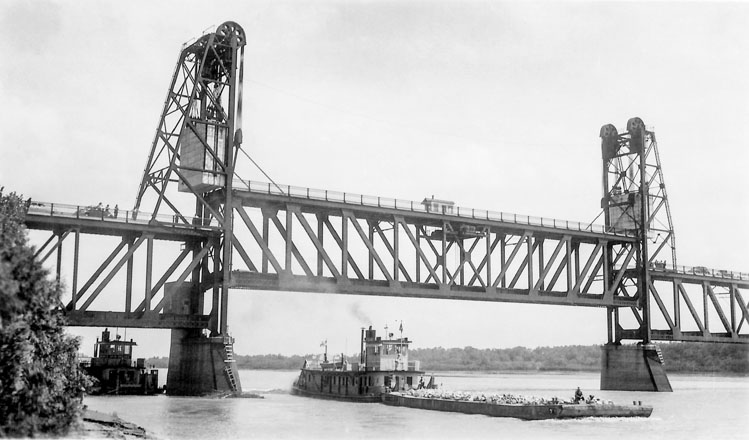 |
| The Meridian Bridge was built with a lift span that rose 25 feet to allow steamboat traffic on the Missouri River to pass underneath. Raising and lowering the 220-foot span took about 8 minutes in each direction. It was deactivated in 1984, and the lifting mechanism was removed. Photo courtesy of the Yankton County Historical Association |
But Means and others kept alive the notion of preserving the bridge, and eventually they gained support from two strangers south of the border: Bob Puschendorf, a native of nearby Norfolk, Nebraska, was then the state historic preservation officer in Lincoln, Nebraska, and John Kingsbury, a banker in Ponca, Nebraska, was chairman of the Nebraska State Highway Commission.
Puschendorf hoped to preserve the bridge for its historical and recreational possibilities. Kingsbury remembers that he was just looking for the finish line.
“The new Yankton bridge was one of the most controversial and environmentally complicated projects of my time on the commission,” he says. “As people in Yankton will remember, there were two factions. One wanted the bridge downtown as it is today and another group preferred a bypass bridge to the east. Nebraska was neutral, but at the time was generally preferring a bypass around communities.”
As the lead state for planning and construction of the new bridge, Nebraska was responsible for public hearings. Kingsbury felt the primary hearing should be in Yankton because the city had so much at stake.
“After discussion between the two states, it was agreed Nebraska could hold a public hearing in South Dakota,” Kingsbury remembers. “I am sure I was the first state commissioner to hold a large public hearing in another state. I believe [South Dakota transportation officials] felt a neutral Nebraskan would be a good choice to lead a controversial public hearing. There was a huge crowd with signs and buttons supporting their cause. The room was packed along with three television stations. The meeting went unexpectedly well. The speakers remained reasonably calm. In the end, both states agreed to the downtown location based on dozens of factors.”
Left in limbo, however, was the fate of the old bridge. A federal Environmental Impact Study favored preservation over demolition.
“Yankton was also asking Nebraska to make the new bridge more attractive than a flat, basic concrete bridge,” Kingsbury recalls. “Nebraska was opposed to the added cost because the many delays had greatly increased the cost projections. As negotiations continued, I recommended Nebraska beautify the new bridge with the pillars and lighting in exchange for Yankton or South Dakota taking ownership of the old, historical bridge.”
South Dakota authorities liked Kingsbury’s compromise, though they didn’t yet know if Yankton would accept responsibility for the Meridian. For nearly a year after car and truck traffic ceased on the old double-decker bridge, conversations and meetings continued in city hall and other locations.
Kingsbury’s proposal created an opening for Puschendorf and Jay Vogt, his counterpart in Pierre. Vogt was director of South Dakota’s historic preservation office; he was also well-acquainted with the Meridian Bridge. His grandparents had lived in Yankton, and one of his favorite childhood memories was of driving over the Missouri River on the double-deck bridge.
Yankton had yet another important connection: longtime local trucker Ralph Marquardt was then serving on the South Dakota Transportation Commission.
Puschendorf, Vogt and transportation officials from both states offered to work with the City of Yankton if its leaders wished to accept responsibility for the historic bridge.
Yankton attorney Nick Moser was a newly elected state representative in 2009. “It was one of the first things I worked on as a legislator,” he says. “All of the lawmakers from Yankton were in favor of preserving it but there were a number of people who were opposed for a variety of reasons: they thought no one would use it, they thought it might not be safe, some even thought it would be an eyesore.”
Moser and Yankton’s other lawmakers met on several occasions with Department of Transportation officials during the 2009 session, and they also organized meetings with Marquardt and city commissioners back home — often gathering at the publishing offices of South Dakota Magazine.
Demolition of the bridge would have involved liabilities, environmental issues such as lead paint and other unknowns, so preservation of the bridge appealed to some state officials who felt it was the safest decision.
Most city commissioners eventually embraced the view that the historic bridge still had something to offer but they were concerned that the city wouldn’t be able to afford restoration costs in the short-term, and that local taxpayers could be stuck with demolition costs sometime in the future.
Those financial worries were alleviated when state transportation officials agreed to devote $1.8 million from South Dakota’s share of the American Recovery and Reinvestment Act, which had been passed by the U.S. Congress to stimulate the economy after the Great Recession of 2008.
Kingsbury and his Nebraska associates, anxious to close the chapter on the Yankton bridge, offered the remainder of the restoration costs, which totaled $5 million. The two states also agreed to deposit their respective shares of the estimated demolition cost into a trust fund so that monies are available for that purpose if needed. The fund was started at $2.8 million but it has nearly doubled.
Two years later — after rehabilitation and the installation of a railing and lighting — the Meridian Bridge was opened to pedestrians and bicyclists in November of 2011. It’s difficult to find any detractors today, and the officials who were involved see it as a success.
“Every time I drive across the new bridge, I smile at the beautification,” says Kingsbury, who is still a banker in Ponca.
“Today I can walk out the front door of my office and I have a full view of the bridge,” says Moser. “I see people walking it at all times of the day, and all times of the year. On weekends from spring to summer and fall it’s packed.”
Means walks the bridge regularly and enjoys seeing the various ways it’s used by the community — from weddings to fundraisers, lovers’ padlocks, family gatherings and, of course, the constant stream of people who simply want to stroll at treetop-level above the grand Missouri River.
Editor’s Note: This story is revised from the September/October 2024 issue of South Dakota Magazine. To order a copy or to subscribe, call (800) 456-5117.

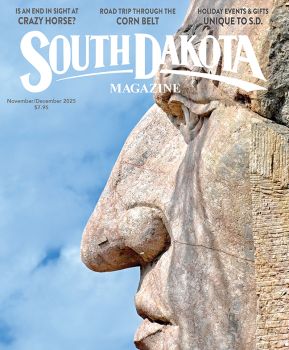
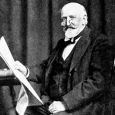

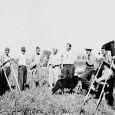


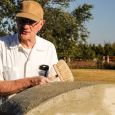
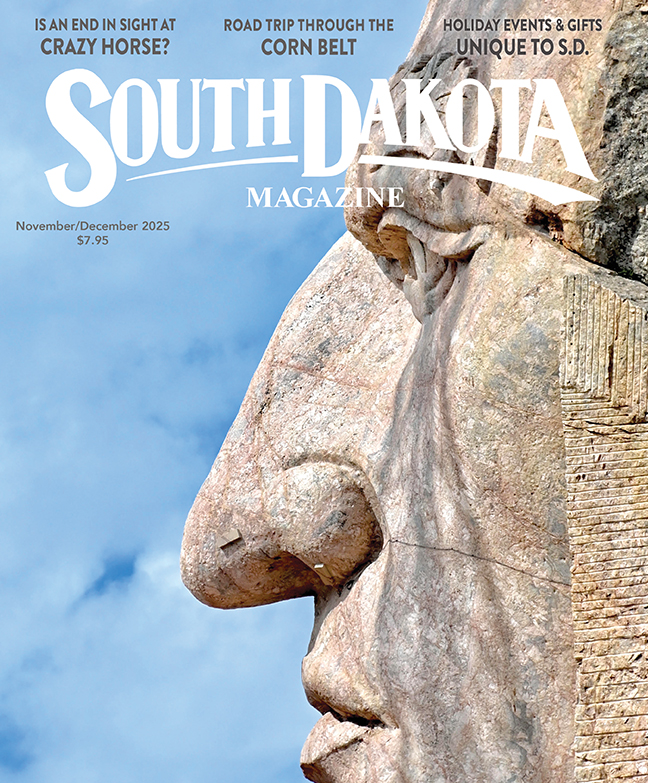

Comments